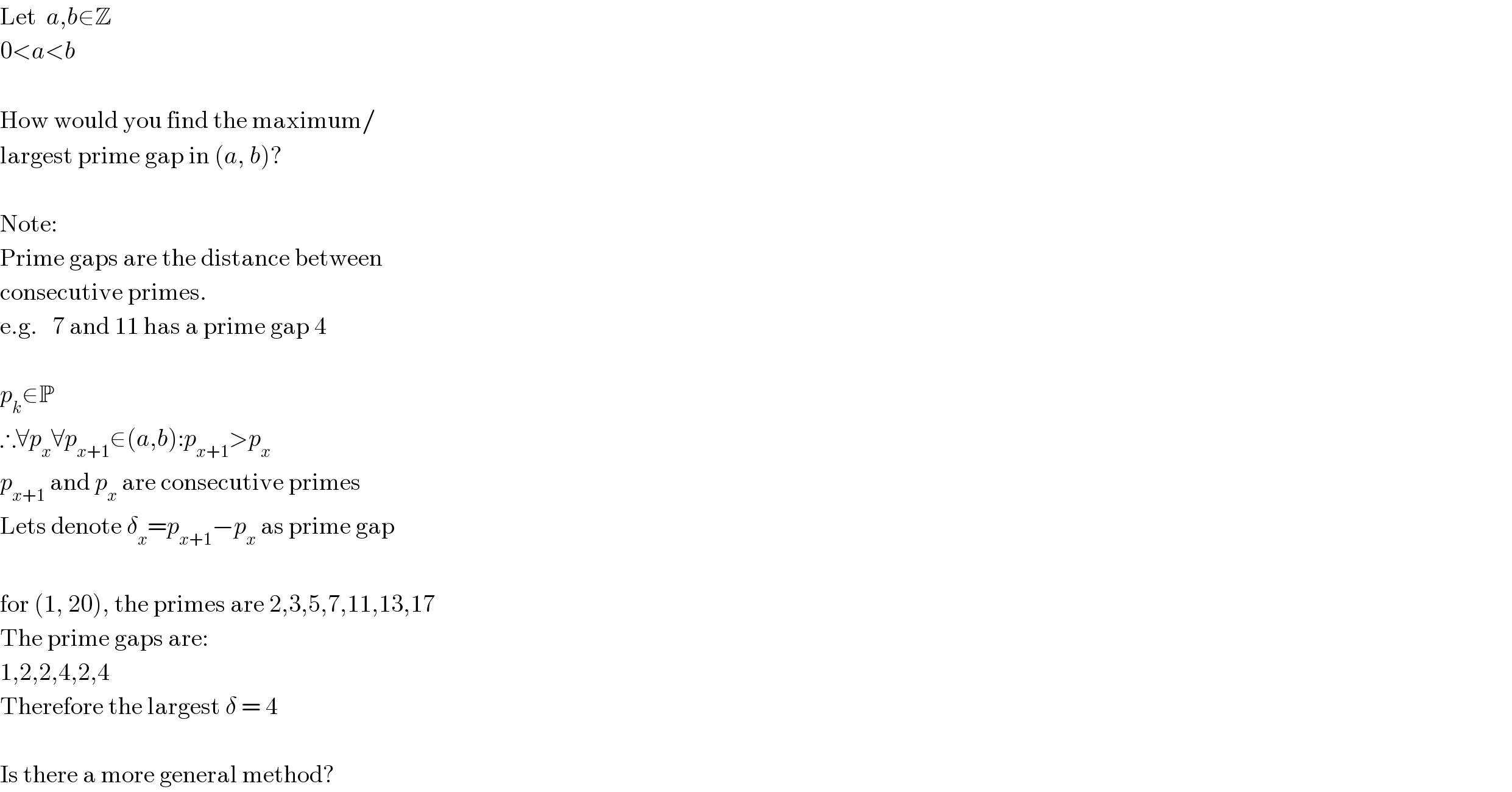
Question Number 21292 by FilupS last updated on 19/Sep/17

$$\mathrm{Let}\:\:{a},{b}\in\mathbb{Z} \\ $$ $$\mathrm{0}<{a}<{b} \\ $$ $$\: \\ $$ $$\mathrm{How}\:\mathrm{would}\:\mathrm{you}\:\mathrm{find}\:\mathrm{the}\:\mathrm{maximum}/ \\ $$ $$\mathrm{largest}\:\mathrm{prime}\:\mathrm{gap}\:\mathrm{in}\:\left({a},\:{b}\right)? \\ $$ $$ \\ $$ $$\mathrm{Note}: \\ $$ $$\mathrm{Prime}\:\mathrm{gaps}\:\mathrm{are}\:\mathrm{the}\:\mathrm{distance}\:\mathrm{between} \\ $$ $$\mathrm{consecutive}\:\mathrm{primes}. \\ $$ $$\mathrm{e}.\mathrm{g}.\:\:\:\mathrm{7}\:\mathrm{and}\:\mathrm{11}\:\mathrm{has}\:\mathrm{a}\:\mathrm{prime}\:\mathrm{gap}\:\mathrm{4} \\ $$ $$\: \\ $$ $${p}_{{k}} \in\mathbb{P} \\ $$ $$\therefore\forall{p}_{{x}} \forall{p}_{{x}+\mathrm{1}} \in\left({a},{b}\right):{p}_{{x}+\mathrm{1}} >{p}_{{x}} \\ $$ $${p}_{{x}+\mathrm{1}} \:\mathrm{and}\:{p}_{{x}} \:\mathrm{are}\:\mathrm{consecutive}\:\mathrm{primes} \\ $$ $$\mathrm{Lets}\:\mathrm{denote}\:\delta_{{x}} ={p}_{{x}+\mathrm{1}} −{p}_{{x}} \:\mathrm{as}\:\mathrm{prime}\:\mathrm{gap} \\ $$ $$\: \\ $$ $$\mathrm{for}\:\left(\mathrm{1},\:\mathrm{20}\right),\:\mathrm{the}\:\mathrm{primes}\:\mathrm{are}\:\mathrm{2},\mathrm{3},\mathrm{5},\mathrm{7},\mathrm{11},\mathrm{13},\mathrm{17} \\ $$ $$\mathrm{The}\:\mathrm{prime}\:\mathrm{gaps}\:\mathrm{are}: \\ $$ $$\mathrm{1},\mathrm{2},\mathrm{2},\mathrm{4},\mathrm{2},\mathrm{4} \\ $$ $$\mathrm{Therefore}\:\mathrm{the}\:\mathrm{largest}\:\delta\:=\:\mathrm{4} \\ $$ $$\: \\ $$ $$\mathrm{Is}\:\mathrm{there}\:\mathrm{a}\:\mathrm{more}\:\mathrm{general}\:\mathrm{method}? \\ $$
